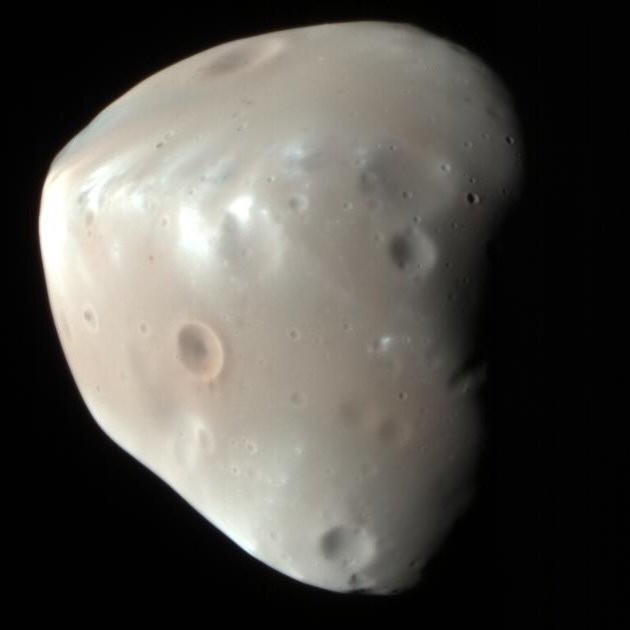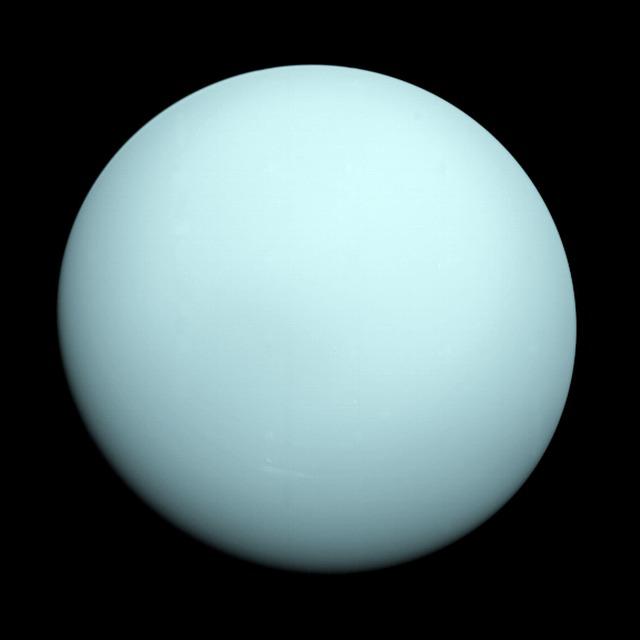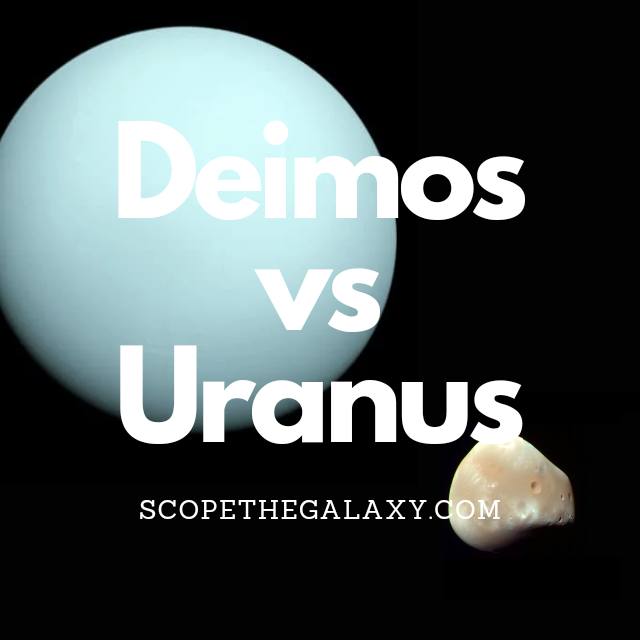*This post may contain affiliate links. This means we may make a commission if you purchase an item using one of our links*
The main differences between Deimos and Uranus are that Phobos is a natural satellite while Uranus is a planet, Uranus has a very drastic axial titl of 98 degrees while Deimos’ is 0 degrees and Uranus is far bigger with a diameter of 50,724km while Deimos’ is 12.4km.
There are various other differences between the two so, continue reading if you want a more detailed look at each of these bodies along with their similarities and differences below.
What Is The Moon Deimos?
Table of Contents

Deimos is the smaller and outermost of the two moons of Mars, named after the Greek God of dread and terror (the brother of Phobos). This satellite was also discovered by American astronomer Asaph Hall just five days before Phobos (12th August 1877).
Scientists like Johannes Kepler had put forward theories for the existence of these moons many years before they were discovered. Their calculations were based on the fact that the planets on either side (Earth and Jupiter) possessed one and four moons, respectively.
Still, none were discovered until the 19th century. One of the main reasons for this is that the tiny size of Phobos and Deimos, combined with an exceptionally close orbit to their planet, means that the glare of Mars often obscures our view of them.
Phobos measures just 15 x 12 x 11 km and completes an orbit of Mars once every 30 hours.
This tiny moon is also a heavily cratered landscape shaped by the impact of asteroid collisions over time. However, the material thrown up from these impacts doesn’t appear to have landed back on the moon’s surface as it usually would. This could be because the lack of gravity on Phobos allowed the ejected material into space.
The surface gravity on Deimos is just 0.003 m/s^2 (compared to 9.807 m/s^2 on Earth), which means the average gravitational pull of Deimos is only 0.003 m/s. With only 1/2500th of Earth’s gravity, you would need a tether to walk on this rocky moon, or every step would put you at risk of achieving escape velocity and launching yourself into space.
The composition of Deimos is similar to Phobos, suggesting that it might also be a captured asteroid. Its surface is very dark gray and has an albedo of around 0.07, meaning it reflects just 7% light (about half of the light Earth’s moon can reflect).
What Is The Planet Uranus?

Uranus is the 7th farthest planet from the Sun and the 3rd largest planet in our solar system, coming in at a diameter of 50,724 km. This means that roughly 63 Earth’s could fit inside this ice giant.
In regards to why this cyan blue planet is referred to as an ice giant, it’s down to it’s composition. Uranus is made mostly of methane, ammonia and water with its atmosphere mostly consisting of hydrogen and helium, much like the Sun, and the other giant planets in our solar system.
Due to its distance from the Sun, it takes Uranus 84 years to complete one orbit our central star, whereas it’s axial rotation is much faster than even our Earth at 17 hours per rotation.
As a result of its distance from the Sun, ice based composition and faster rotation levels, Uranus is far from an ideal place to live in let alone have the potential to support life.
Its base temperature is generally a chilling -190 to -200 degrees Celsius and its rocky core, although hot, is still on the cooler side for a large planet sitting around the 5,000 degrees Celsius range.
The planet’s winds are also very fast often hitting 900 km/h, which is roughly twice that of Earth’s most powerful turbulent wind speeds.
In regards to the moons surrounding this cyan planet, we’ve discovered 27 small ones orbiting it. Furthermore, it has 13 rings surrounding it which also means Uranus has the most abundant collection of rings surrounding in our solar system, which is even more than Saturn.
One of the Uranus’ most unique features would include the manner in which it rotates around its axis. As opposed to the slightly angled rotation that the likes of Earth, Saturn and most other planets display, Uranus’ axis is positioned at a 98 degree angle.
What this means is this ice giant completes an axial rotation on its side as opposed to the relatively up straight positioning of most of the other planets in our solar system.
Similarities Between Deimos And Uranus
There are a few similarities that Uranus and Deimos share, which in this case includes the following:
- Both are part of the same solar system.
- Neither have tectonic plates.
- Both orbit another larger object.
Differences Between Deimos And Uranus
As for the differences between the two, they include the below.
- Deimos orbits Mars whilst Uranus only orbits the Sun.
- Uranus is a spherical shape while Deimos is not.
- Uranus has 27 moons orbiting it while Deimos has none.
- Uranus is an ice based gas giant planet whilst Deimos is a terrestrial based natural satellite.
- Uranus has a diameter of 50,724km whilst Deimos has a diameter of 12.4km.
- Deimos has no atmosphere whilst Uranus is composed of helium, hydrogen and methane.
- A day on Deimos takes 30 hours whilst a Uranus day takes 17 hours.
- It takes Deimos 30 hours to orbit Mars and the Sun in 687 days whilst Uranus orbits the Sun 84 years.
- Deimos’ temperature ranges between -4 to -112 degrees Celsius whilst Uranus has an average temperature of -190 degrees Celsius.
- Uranus has an axial tilt of 98 degrees whilst Deimos’ axial tilt is closer to 0.
- Uranus’ density is 1.27 g/cm³ whilst Deimos density is 1.47 g/cm³.
- Uranus’ mass is 8.681 × 10^25 kg whilst Deimos’ mass is 1.4762 × 10^15 kg.
- Deimos’ gravitational strength is 0.003 m/s² whilst Uranus’ is 8.87 m/s².
- Deimos is tidally locked to Mars whilst Uranus is not tidally locked to any entity
- Uranus has a magnetosphere whilst Deimos has no magnetic field.
- Deimos has no core while Uranus has a hot central core.
- Uranus has 9 rings while Deimos has 0.
Summary
Deimos and Uranus have very few similarities such as the fact both are a part of the same solar system and also orbit a far larger body than themselves.
They definetly are more different than similar whether it be in regards to size, mass, the number of objects that orbit them, the magnetic fields they have and more, so most shouldn’t struggle very much in disntinguishing them from one another.

